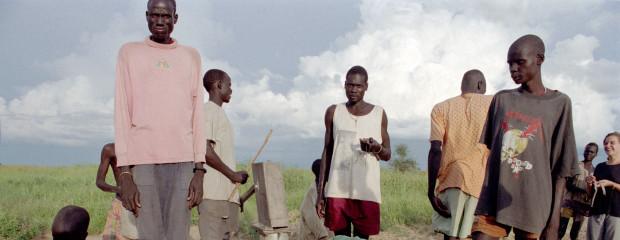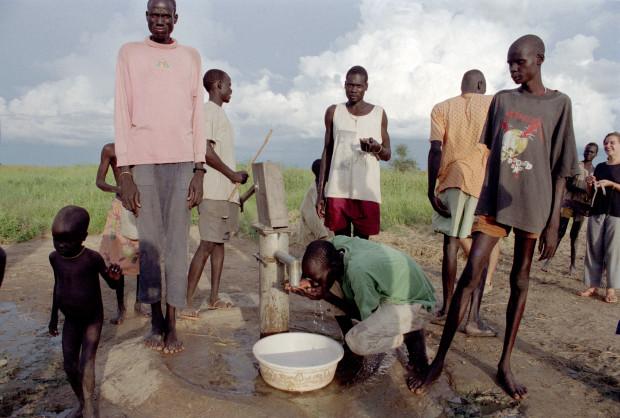May Awakening: South Sudan famine raises memories of 1998 – By Michael Medley

Warnings of a looming famine begin early in the year, and intensify quickly. Hundreds of thousands of people have been forced to flee their homes; many are urban-dwellers, displaced into already-impoverished rural areas and overcrowded relief centres. Relief agencies which for years have been ministering to quieter hardship and more confined emergencies are wondering whether and how to scale up their capabilities. They probably ought to be recruiting many more staff, training and integrating them, buying extra equipment, and loading larger quantities of relief into that frustratingly long pipeline. But little of this can be done yet, as they still lack enough money – or solid promises of future money – to justify the investment.
Most of the big donor states have made a preliminary contribution to the current inter-agency humanitarian appeal, but they desire more clarity about the situation before taking a bigger step. They realize that the recent fighting will have disrupted many people’s livelihoods, but also know that people have various ways of coping with adversity which can absorb some of the shock. Just how much of the shock they can absorb never seems to get very clear.
Then there are the questions of whether the field agencies will really be able to reach the needy people. The territory is huge, roads are dreadful and the rainy season will make many impassible. Some donors are still clinging to the hope that they can avoid having to pay massive costs of air transportation. Money might have been saved if more relief supplies had been pre-positioned by land earlier in the year. But in the worst-affected places the situation has been too unsafe.
So the humanitarian agenda has featured for months in the growing efforts of diplomats from IGAD and Western countries to broker agreement between the warring parties. The diplomacy reaches a climax in early May with a visit to the region by the Secretary-General of the United Nations. An apparent breakthrough on humanitarian access is achieved.
It is May 1998 and it is May 2014. What happens next? Before trying to answer this question, I will differentiate the two episodes. Although there are remarkable parallels and echoes between the early stages of the 1998 and (prospective) 2014 famines, the differences are important.
The unfolding of the 1998 famine
In 1998 the famine would take place mainly in greater Bahr al-Ghazal. Certainly the disaster – then as now – was largely war-induced, but the principal warring parties at that time were the Government of Sudan (GOS) and the main rebel group in southern Sudan, the SPLM/A. They had been fighting for about 15 years. In the northern part of Bahr al-Ghazal, GOS had long sponsored various militias which mounted periodic raids on civilian as well as military targets, killing and abducting, stealing cattle and grain, destroying homes and crops.
Looking back from 2014 it might seem surprising that famine was not a continual state of affairs in the mid-1990s. There was almost no infusion of government salaries into the rural areas through soldiers, teachers and other civil servants. Trade for the importation of extra food, agricultural supplies and other goods was extremely limited. International aid agencies sprinkled relief, but on a much smaller scale than was to be the case in the post-war years. Aid mostly had to reach Bahr al-Ghazal by air. The 1998 Consolidated Appeal put the food aid target for Southern Sudan at 49,000 tonnes. (By comparison: the requirement of the World Food Programme (WFP) in 2013 was 225,000 tonnes.)
Three shocks tipped chronic deprivation onto a path which led to overt famine. One was unusually poor weather during the growing season in 1997. The erratic rainfall that year has been attributed an unusually strong El Nino effect in global climate (an event which many scientists fear will recur this year). A second factor was military. 1997 had seen a remarkable string of success for the SPLA as, assisted by Museveni’s Uganda, its major attack force moved northwards on the west side of the Nile, capturing many towns including Kaya, Yei, Mundri, Rumbek, Tonj, Warrap and Yirol. These were points of external supply from which resources had diffused into the local economy: a benefit now lost. At the same time, the increased presence of SPLA troops in Bahr al-Ghazal meant heavier taxation of food from villagers there. But the most important shock was a mass displacement event. An unsuccessful rebel attempt to capture Wau resulted in as many as 100,000 people fleeing from the environs of the town into rural areas. Many from this group would die in the famine, as would many elderly people and young children of single mothers who under conditions of stress had become relatively detached from the supportive relationships of kin and community.
By May 1998, displaced and desperate people had begun camping at airstrip locations where food was known occasionally to be distributed. These places became “˜relief magnets’: their reputation for food distributions attracted the needy, the needy attracted more relief and more aid agency workers, and the quantities of all three spiraled upwards. Aid workers were very conscious of the dangers of this clustering: the creation of unsanitary and overcrowded settlements where disease would spread easily, tensions become acute with the pre-existing local community over access to land and other resources, and concentration of supplies facilitate their taxation and other forms of capture by local authorities and armed forces. But the dynamic quickly became too strong to reverse.
In one way the “˜relief magnet’ effect was conducive to the aid effort. It created centres of acute suffering from where journalists could conveniently file shocking reports, belatedly pumping up public pressure for more donor funding. In the end the 1998 Consolidated Appeal target was greatly exceeded and more food was delivered to some locations than could usefully be distributed. But meantime tens of thousands of people had died from hunger-related causes.
Why didn’t the relief operation get going early enough to forestall the worst of these effects? Donors were unconvinced of the seriousness of the threat and the feasibility of the response until too late (and the lag between donation and relief is several months). But conviction about these matters is not a purely rational process: it is bound up with political commitments and ideas engrained in organizational thinking about what is realistic and what is not. In 1998 the US – always the main source of food aid – held back from any large donation until the end of April. I believe this was at root due to a priority of geo-strategy.
Political background of famine relief in 1998
The US had added Sudan to its list of state sponsors of terrorism in 1993, and since 1995 had been supporting an alliance of “˜frontline states’ opposed to a spread of jihadism in the region. These states – Eritrea, Ethiopia, Uganda and also Rwanda – more or less discreetly backed the SPLM/A in its war against the regime of President Bashir. The SPLM/A’s spectacular gains in 1997, helped by Uganda in particular, served to intensify the pressure on Khartoum. Visits to East Africa by US State Secretary Albright in December 1997 and President Clinton himself in March 1998 sought to consolidate the alliance to “˜isolate’ the Sudanese regime and, it appeared, to further increase support for the SPLM/A and other Sudanese opposition groups with a view to bringing about regime change.
Faced with this threat, GOS in early 1998 was seeking international support for a ceasefire in southern Sudan. It made its appeal especially to the UN and European states, which tended to be uncomfortable with the belligerence of the US approach.
The question of the ceasefire was closely linked with the growing problem of humanitarian access. Most of the aid agencies working in the rebel-held areas did so under the auspices of a negotiated access agreement bound by the principle of humanitarian neutrality and supervised by the UN. The arrangement was called Operation Lifeline Sudan (OLS). Under OLS, GOS reserved the right to approve all aircraft and flight timetables.
The vast majority of relief for greater Bahr al-Ghazal had to be transported by air. But after the attack on Wau in the first days of 1998, GOS had imposed a flight ban in the name of security. European diplomats moved to and fro, and the flight ban was gradually modified during the following months, albeit hedged with bureaucratic complications. It remained an apparent obstacle to adequate relief operations through the months of increasing desperation until early May when UN Secretary-General Kofi Annan brokered the crucial access agreement. In effect, Khartoum used its authority over humanitarian access as a resource in negotiations in order to reach a ceasefire or – what was just as useful from its point of view – the rainy season and a full-blown humanitarian crisis amid which international toleration of further major SPLA attacks was unthinkable.
Conversely for the US, the eventual unavoidability of a major UN-based relief operation frustrated its proxy-war strategy. After television pictures of incipient famine began appearing in the world media (which had happened by mid-April) a meeting of President Clinton with his National Security Advisor and Secretaries of State and Defence made the decision to change tack. USAID announced its first major donation to the World Food Programme while Kofi Annan was arranging the key access agreement.
Although this real-political decision was, I believe, the main determining factor in the timing of the relief operation, the fact was largely obscured by indignation expressed in the media over the perceived inhumanity of Khartoum and impotence of the UN. Attention was also diverted by debates over the reliability of the famine warnings and – less sensibly but more passionately – the appropriateness of using the word “˜famine’. Certain aid agency departments and staff had invested heavily in developing their expertise as measurers of food insecurity and specialists in food aid policy. Conscious also of the post-cold-war flourish of literature on the unintended consequences of relief – and probably influenced too by donor views of what constituted “˜realistic’ amounts of aid – some of the experts attempted to use their intellectual prestige to belittle the early cries of “˜famine!’ (while agreeing that there was a looming crisis of food security). “˜Not famine yet’ remained the stance of UN agencies as long as two months after the international press had begun showing pictures of emaciated bodies. This became a spicy topic for public controversy, especially in the UK.
Reconfiguration in 2014
By July 1998 more than a hundred people were dying malnourished on an average day among the 18,000 or so gathered at the aid magnet location of Ajiep. The horrors of starvation were also being experienced at many other relief centres throughout Bahr al-Ghazal. Back to the future in May 2014 we may wonder if we are heading so soon for scenes like this. Nobody really knows, but nobody should be confident that we are not.
True, 2014 seems to have some significant advantages. In 1998 the people of Bahr al-Ghazal had been living on the edge of survival in a war zone for years. Many were down to a minimal level of household assets and bodily strength even before the shocks of 1997 and the Wau exodus. Before December 2013, on the other hand, South Sudan had been largely at peace for a decade. Even the parts of Jonglei worst affected by regional conflict still felt benefit from networks of trade and salary-remittance. However, the matter of people’s resilience is doubtless not as simple as this. It may be that people who have become used to a peacetime lifestyle find it harder to manage during the return of wartime conditions.
Then again, 2014 has in place a stronger network of humanitarian agencies, notably including UNMISS, the UN peacekeeping force. The camps protected by UNMISS have already saved thousands from violent death. But as the experiences of 1998 and many other disasters remind us, camps will turn into hells. In some places they have already done so: scenes of dire food shortage, conflict between groups within them and with local communities outside, appalling sanitary conditions and now an outbreak of cholera. Worse is likely to come as their numbers swell. It is illusory to think that even with the help of UNMISS anyone will be able to run them tidily.
As in 1998 the agencies hope to reduce the clustering of desperate populations by arranging quick singular relief distributions in remote areas. Compared with the war years, the road network provides a more realistic option for transporting relief, but it is nevertheless highly treacherous in the rainy season even on major routes. In 2014 the most-affected states are more readily reached by barge transport than they were when the epicentre of disaster was in Bahr al-Ghazal. But road and barge are mainly useful for transporting supplies to the major centres. They cannot reach the majority of villages, especially not if insecurity remains a problem. Widespread air-dropping will have to be used for that.
The success of relief distributions, especially in remote areas, will be sensitive to the attitudes of local leaders and military units. 1998 suggests that it will often be delusory and counter-productive to target exclusively the “˜most vulnerable’ within communities. If such distributions take place, the goods are likely to be forcibly re-distributed afterwards. Many of those who died in 1998 were people who lacked the right family or clan relationships within the informal distribution systems. Relief agencies must try to understand who these people are, and help them with special measures, but within the context of broader distributions. It is not easy to do. Meanwhile, unless some alternative way is found of paying and feeding SPLM/A-IO, White Army, and other rebel fighters, they will almost inevitably take much of the relief in their areas. Perhaps some units of the government’s SPLA will do the same.
This thought leads to reflection on the difficult relationship between the relief operation and both the peace process and the agenda of bringing war criminals to account for their crimes. The relief operation must adopt the ideals of neutrality but will not be neutral in effect. Even if UNMISS were fully funded and given a strong mandate to protect relief, the aid agencies would still often rely on labour and systems owned by local oligarchs and security conditions determined by nearby fighters. Maintaining the cooperation of these actors is likely to depend continuously on their attitudes to the higher political process and the tactics of the top leaders at the negotiating tables. The existence of the relief operation increases the pressure on the international community to ensure that the SPLM-IO is treated as a legitimate party in the talks, and it is hostage (in some sense at least) to war criminals who may feel under threat.
The side-effects of the humanitarian imperative understandably create doubts about the whole enterprise in both donor and recipient countries. My impression is that public attitudes have gained in maturity over the last 16 years, by familiarity with many hard examples. The shock when the gulf is revealed between the ideals and the practicalities of relief in complex emergencies is now less frequently one of mere indignation or despair. Some may reasonably argue that the big famine intervention is a pattern in global power that we should resist. But I for one will welcome a large increase in relief funding following the Oslo donor conference on 20th May. On the model of 1998 I then expect an agonizingly slow gear-up of agency operations followed by a frenzy in which they are falling over each other, patently failing to help many thousands of people, and yet helping some.
It should have started earlier. The rainy season is now upon us. The donors have supplied less than half of what the field agencies requested for the first six months of the year. They – and we – should have thought harder about the risks. Our imaginations have perhaps been too full with the political and military manoeuvres, and with our outrage at the perpetrators of unspeakable cruelties. The mind’s eye should have followed more intently all the people who had left their homes.
Michael Medley is editor of SouthSudanCivics.info. Much of the above article is based on his doctoral thesis, Humanitarian parsimony in Sudan: The Bahr al-Ghazal famine of 1998 (University of Bristol, 2010), which can be accessed in full here.







The looming famine in South Sudan is man made that to say, the current regime of president Salva Kirr is responsible of the mess and suffering people of South sudan is going through by concoucting a coup by his former vic president Riak machar on Dec 15th 2013.
kirr is failed leader who mismanaged oil revenue through corruption by his ministers and his close relatives.
Wonderful article. I remember the 1998 famine well as, though then living in the UK, I have a strong interest in South Sudanese affairs. Now having lived in Juba for over 8 years, I was stunned by the first section. I’ve taken part in so many conversations about this looming tragedy, expended so much emotion about it- horror, fear, hope, guilt. How different history seems when you’re in the middle of it, to the view from outside. And how strange the repetitions, determined though they are by similar and predictable pressures